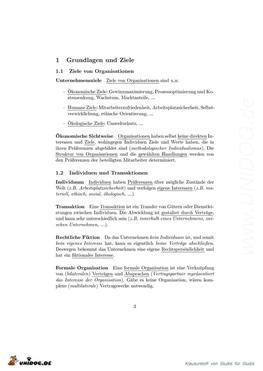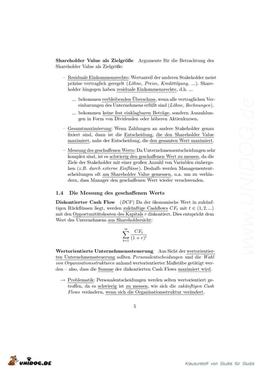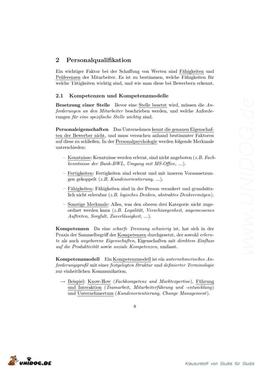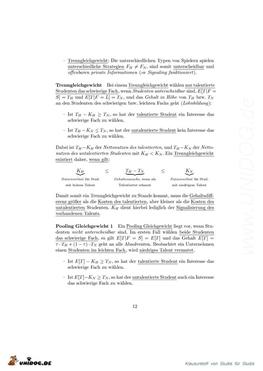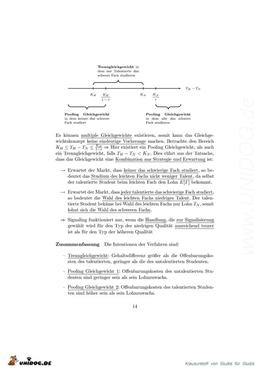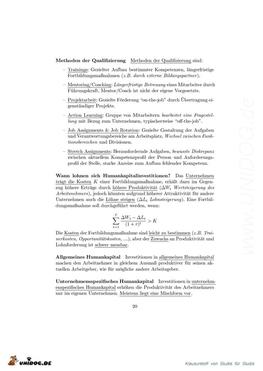| Dokumente | |
|
|
Dokumentvorschau |
Organisation und Personal |
Dokument-Nr.: F-ABF8 |


|
|
Dokument-DownloadUm Zugriff auf dieses Dokument zu erhalten, musst Du Mitglied der UNIDOG Community sein. |
|
Inhalt / Beschreibung
Eine ausführliche Zusammenfassung der Inhalte, die in der Vorlesung "Organisation und Personal" behandelt wurden.
Inhaltsverzeichnis der Zusammenfassung
1 Grundlagen und Ziele 1.1 Ziele von Organisationen . . . . . . . . . . . . . . . . . . . . . 3 1.2 Individuen und Transaktionen . . . . . . . . . . . . . . . . . . 3 1.3 Effizienz und Wertmaximierung . . . . . . . . . . . . . . . . . 4 1.4 Die Messung des geschaffenen Werts . . . . . . . . . . . . . . 5
2 Personalqualifikation 2.1 Kompetenzen und Kompetenzmodelle . . . . . . . . . . . . . 8 2.2 Talent . . . . . . . . . . . . . . . . . . . . . . . . . . . . . . . 9 2.2.1 Signaling . . . . . . . . . . . . . . . . . . . . . . . . . 10 2.2.2 Screening und Selbsteinordnung . . . . . . . . . . . . . 15 2.3 Kompetenzmessung und Personalauswahl . . . . . . . . . . . 15 2.4 Humankapital . . . . . . . . . . . . . . . . . . . . . . . . . . . 17 2.4.1 Schulische Bildung . . . . . . . . . . . . . . . . . . . . 18 2.4.2 Betriebliche Bildung . . . . . . . . . . . . . . . . . . . 19
3 Leistungsmotivation und Anreize 3.1 Anreizsystem und -strategie . . . . . . . . . . . . . . . . . . . 23 3.2 Der Trade-Off zwischen Risiko und Anreizen . . . . . . . . . . 24 3.2.1 Risikopräferenzen . . . . . . . . . . . . . . . . . . . . . 25 3.2.2 Das LEN-Modell . . . . . . . . . . . . . . . . . . . . . 26 3.3 Das optimale Entlohnungsschema . . . . . . . . . . . . . . . . 27 3.4 Das Multitasking Problem . . . . . . . . . . . . . . . . . . . . 30 3.5 Teamanreize und Trittbrettfahrerprobleme . . . . . . . . . . . 31 3.6 Fairness und Motivation . . . . . . . . . . . . . . . . . . . . . 33 3.6.1 Equity Theorie nach Adams . . . . . . . . . . . . . . . 33 3.6.2 Fair-Wage-Effort Hypothese . . . . . . . . . . . . . . . 34 3.7 Subjektive Leistungsbewertung . . . . . . . . . . . . . . . . . 35
4 Organisationsgestaltung 4.1 Begriffe . . . . . . . . . . . . . . . . . . . . . . . . . . . . . . 38 4.2 Arbeitsteilung . . . . . . . . . . . . . . . . . . . . . . . . . . . 38 4.3 Entscheidungsrechte . . . . . . . . . . . . . . . . . . . . . . . 40 4.4 Organisationsstrukturen . . . . . . . . . . . . . . . . . . . . . 41 4.4.1 Funktionalorganisation . . . . . . . . . . . . . . . . . . 41 4.4.2 Divisonalorganisation . . . . . . . . . . . . . . . . . . 42 4.4.3 Matrixorganisation . . . . . . . . . . . . . . . . . . . . 44 4.5 Geschäftsprozessorganisation . . . . . . . . . . . . . . . . . . 45 4.5.1 Business Process Reengineering . . . . . . . . . . . . . 46 4.5.2 Six Sigma . . . . . . . . . . . . . . . . . . . . . . . . . 47 4.5.3 Outsourcing und Shared Service Center . . . . . . . . 48 |
Dokumentbewertung (20)
Kommentare
Dokument empfehlen

|
||||||||||||||||||||||||||||||||||||||||||||||||||||||||||||||||||||||||||||||||||||||||
|
Vorschau-Ausschnitte
|
|||||||
